Winner of the Spiel Des Jahres back in 2018, Azul is a game that has quickly gained a high reputation in the board game industry. It takes a lot to be rated as one of the best 50 games of all time on Board Game Geek. Due to its acclaim and the fact that the game combines tile placement and set collection mechanics (two of my favorites) it was an inevitability that I would eventually want to try out Azul. Outside of a basic knowledge of the game and all of the acclaim that it has received, I didn’t know a lot about Azul so I didn’t know what to expect out of it. While a little overrated Azul is an interesting and unique combination of mechanics leading to an experience that most people should enjoy.
How to Play Azul
Setup
- Each player takes a player board and turns it so the side with the colored wall is face up (the other side is used for the variant game).
- Each player takes a scoring marker and places it on the “0” space on their gameboard.
- Place the factory displays in the middle of the table in a circle. The number of factory displays that you place will depend on the number of players:
- 2 players: 5 factory displays
- 3 players: 7 factory displays
- 4 players: 9 factory displays
- Fill the bag with the tiles and shake them up. Tiles are randomly taken from the bag and added to the factory displays. Four tiles will be placed on each factory display.
- The player who has most recently visited Portugal will start the game and will take the starting player marker.
Playing the Game
Azul is played over a number of rounds. Each round consists of three phases:
- Factory Offer
- Wall-Tiling
- Cleanup
Factory Offer
The factory offer phase begins with the first player placing the first player marker in the center of the factory displays. The first player will then get to choose which tiles they would like to take. On a player’s turn they can choose tiles from two areas.
First a player may take all of the tiles of one color from one of the factory displays. The rest of the tiles from the factory display are put into the center of the table.
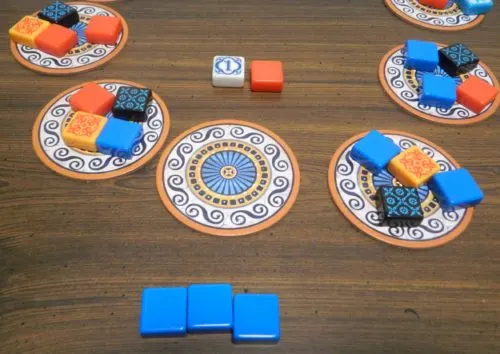
This player chose to take tiles from a factory display. They took the three blue tiles from the display and added the last red tile to the center.
Otherwise a player can choose all of the tiles of one color from the center of the table. The first player to take tiles from the center of the table during a round will also take the starting player marker and place it onto the furthest left space in their floor line (see below).
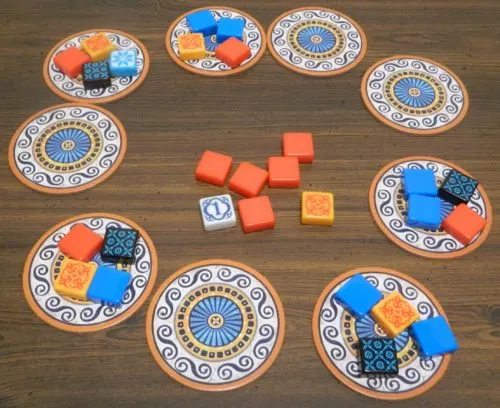
As there are five red tiles in the center this player has chosen to take them from the center for their turn. They will take the five red tiles as well as the first player marker as they were the first to take tiles from the center.
Once a player has taken their tiles they will have to place them on their gameboard. Tiles taken during this phase are added to the pattern lines section of the board (the left side of the board). There are five different lines with each line requiring a different number of tiles. The tiles that the player just picked up will be added to one of these lines starting with the furthest right space that is still unoccupied.
When choosing which line to place tiles on you must follow these rules.
- All of the tiles must be added to the same line and cannot be split between two or more lines.
- If a line already holds tiles of a color, only tiles of the same color may be placed on that line.
- If a player has already completed a color for the line in a previous round, they may not add tiles of that color to the line in future rounds.
- Once all of the spaces in a line have been filled, the line is complete. No more tiles can be added to the line.
- If a player cannot fit all of the tiles they picked up on one line or they don’t want to use all of the tiles they picked up, they can add the tiles to the floor line (the line at the bottom of the gameboard with negative numbers above the spaces). The extra tiles will be placed starting on the left side. If you fill up all of the spaces of your floor line, the extra tiles are returned to the box.
After a player has taken tiles and placed them on their board, play will pass to the next player clockwise. Players will keep taking turns until all of the tiles have been taken from the factory displays as well as the center of the table. Play will then move onto the Wall-Tiling phase.
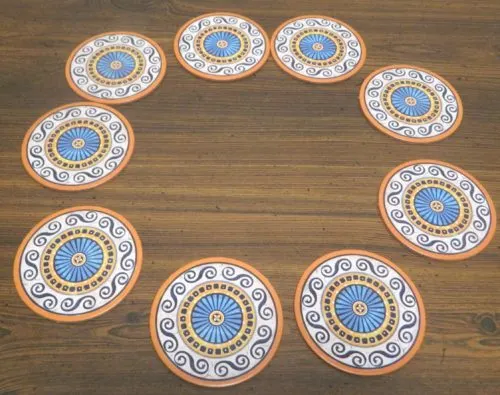
All of the tiles have been taken from the factory displays and the center. Play will proceed to the wall-tiling phase.
Wall-Tiling
In the Wall-Tiling phase players will move tiles from the pattern lines to their walls. All of the players can tile their walls at the same time.
Starting with the top pattern line you will analyze each line to determine if you can move a tile over to your wall. For a tile to be moved over to the wall all of the spaces in the corresponding pattern line have to be filled in with tiles. If a tile can be moved over take one of the tiles and move it over to the corresponding colored space in the same line on the wall. All of the other tiles in the pattern line will then be returned to the box. The player will analyze all of the lines and move over the corresponding tiles to the wall. All of the tiles in incomplete lines will remain where they are for the next round.
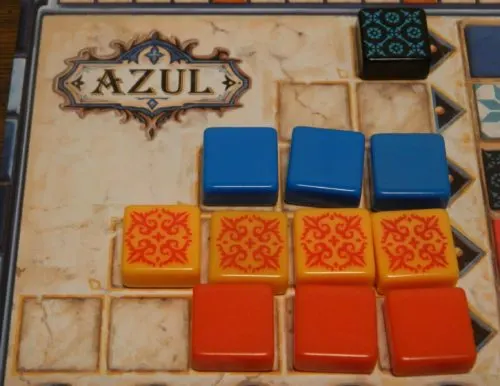
This player will move tiles from the first, third, and fourth rows to their wall because they completed the lines. The tiles on the fifth line will stay there for the next round as the line wasn’t completed.
After a tile is placed in the wall the player will immediately score points for the adjacent tiles (not diagonally). First count up the number of tiles that are connected horizontally to the newly placed tile (including the tile you just placed). The player will score points equal to the number of adjacent tiles. Next count up how many tiles are connected vertically to the newly placed tile (including the tile that was just placed). If the placed tile has tiles vertically and horizontally connected to it, they will score points for both directions. All point gains and losses are applied by moving the scoring marker on the players’ boards.
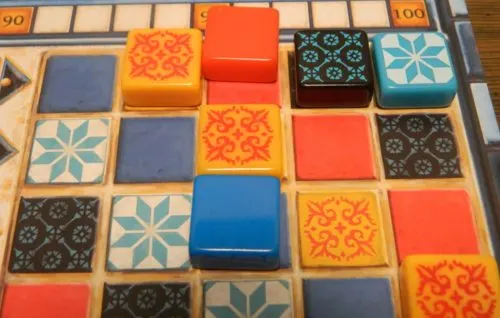
This player has just added the red tile in the top row to the wall. They will score four points for the horizontal line and three points for the vertical line for a total of seven points.
After a player has completed placing and scoring all of their tiles, they will look at the tiles that were placed on their floor line. For each tile placed in the floor line the player will lose the amount of points displayed above the space. After losing the points all tiles on the floor line will be added to the box. The starting marker token will remain on the player’s board though.
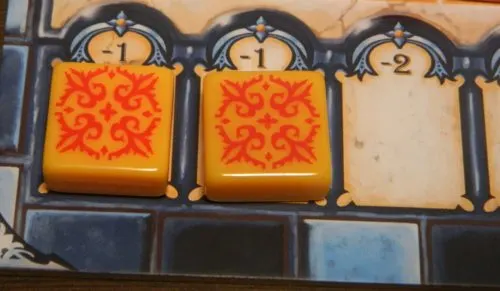
This player has two tiles in their floor line. They will lose two points and then return these two tiles to the box.
Cleanup
If none of the players have filled in all five spaces in one of the horizontal lines on their wall, another round will be played. To prepare for the next round the factory displays are refilled with four randomly chosen tiles from the bag. If the bag runs out of tiles, add the tiles from the box to the bag. If there are still not enough tiles left to fill in all of the factory displays, some of the factory displays won’t receive all four tiles.
After all of the factory displays have been filled another round begins with the Factory Offer phase. The player who took the first player marker in the previous round will return the marker to the center of the table and will start the next round.
End of Game
The game will end when one of the players complete one of the horizontal lines in their wall. Everyone will continue tiling their wall and scoring points like normal. After everyone has completed the Wall-Tiling phase the game will move to final scoring.
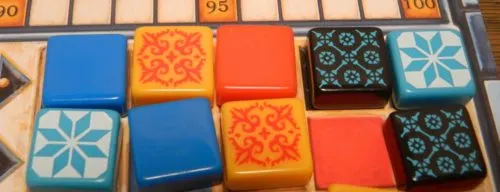
A player has completed the top row of their wall. The game will end at the end of the current round.
Before comparing scores players can score bonus points for completing various goals during the game.
- Players will score two points for each horizontal line they complete in their wall.
- Players will gain seven points for each vertical line they complete in their wall.
- If a player places all five tiles of a color into their wall, they will score ten points for each color they complete.
Players will then compare their scores. The player who has scored the most points will win the game. If there is a tie the tied player who has completed the most horizontal lines will win the game. If two or more players are still tied, the tied players share the victory.
Variant Game
For the variant game you will use the side of the gameboards that have the gray wall. The game is played the same as the normal game except for when you add tiles to the wall. When adding a tile to the wall you can place the tile on any space in the corresponding line that doesn’t currently have a tile on it. Additionally you can’t have two tiles of the same color in either the same horizontal or vertical line.
My Thoughts on Azul
When I read through the rules for Azul I have to admit that the game is not what I expected it to be. I knew the game was going to be a tile laying game combined with a set collecting game. I didn’t know how the two mechanics would work together though as the genres are quite a bit different. Ultimately Azul comes up with a unique way to combine the two genres. I would say that Azul’s gameplay basically breaks up into three different components. These three components work together to allow you to draw tiles and place them into your wall to score points.
Each round begins with choosing which tiles you would like to take. The game gives you two options when choosing tiles as you can either take tiles from a factory display or from the center. Instead of just taking one tile though, you will pick one color and take all of the tiles of your chosen color from the tile location you chose. This means that you can end up taking just one tile or you could end up picking up quite a few tiles of the same color. Choosing tiles is a pretty simple mechanic but it is easily the most important to your success in the game. You will have no chance of winning the game if you don’t pick the right tiles.
The one mechanic that I wasn’t expecting from Azul were the pattern lines. In most of these type of tile laying games you acquire the tiles and then immediately place them to their final destination. Azul takes a sort of detour as there is a middle step before you are able to place any tiles in your wall. Before you can place any tiles into your wall you need to first complete a pattern line with tiles of the same color. The game has a couple rules that must be followed when placing tiles in pattern lines, but the mechanic is quite straightforward. If you fill all of the blank spaces in a line on the left side of the board you can then move one of the tiles over to the right side in order to score points.
At first I thought this mechanic sounded really weird as you had to fill in lines just to add a tile to another part of the gameboard. It might seem odd and might confuse some players when they first play the game, but I think it is a very interesting mechanic. This mechanic is where the set collecting mechanic comes into the gameplay. To fill in a piece of your wall you don’t have to just acquire the tile you need, but you have to collect a set of tiles of the color. Depending on where you want to play the tile you will have to collect between one and five tiles of the color. This obviously makes it easier to place tiles in the top lines as you don’t need to use as many tiles.
This mechanic adds some interesting decisions to the first mechanic of picking tiles. At first most people would think that you would always want to take colors that give you more tiles. More tiles allow you to fill in more spaces in the pattern lines. If you have the spaces to utilize them on a single line it is usually a good thing to take more tiles as it gets you closer to being able to place another tile in your wall. As you get closer to the end of the factory offer phase though the number of tiles you pick up becomes a crucial decision. Instead of just taking a bunch of tiles and placing them on different pattern lines, you want to try and acquire colors you need to finish off pattern lines. You never want to be left with more than one or two pattern lines that you can’t finish in a round. If you have too many partially filled lines you limit how many points you will score in a round while also limiting what you can do in the next factory offer phase. You also don’t want to end up taking too many tiles of a color where you have to add some of the them to the floor line. This adds some interesting decisions to the game as you figure out which color tiles you need to take and time when you should take them so you get the colors you need without having to take too many extra tiles.
The final mechanic in the game is what forms your strategy for the entire game. Placing tiles into the wall is quite basic. If you completed the corresponding pattern line you move one of the tiles over to the space of the corresponding color. Where the strategy comes from is determining which spaces in your wall you are going to target. Basically you want to place tiles into your wall that will score you the most points. Some thought has to go into what tiles you end up taking as a key to winning the game is to try and place tiles that will allow you to score in two directions at the same time. Thus you want to target tiles that will allow you to score both vertically and horizontally as much as possible. You want to acquire tiles that are near one another in the wall so you can assemble vertical and horizontal lines.
While the scoring is pretty straightforward, it is one of the reasons that Azul is a game that you will get better at the more you play it. In your first couple games you aren’t going to exactly know how you should place tiles in order to maximize your score. This is because the game requires you to plan ahead quite a bit in order to succeed. You could play the game without a plan but you are going to have a hard time winning the game. For the best results you need to have a good idea of what you want to do over the next couple of rounds. It is unlikely that you will get to do everything you want, but having a plan is really helpful. If you know what you want to do you can better plan what tiles you want to take as well as figure out which colors you want to put on each pattern line.
Between all of these mechanics I had fun with Azul. Azul is a really interesting combination of mechanics that work pretty well together. While I have never played a game quite like Azul before, the game reminded me of Qwirkle. I have not yet reviewed Qwirkle here on Geeky Hobbies, but it is a game that I really enjoy. I think the comparison to Qwirkle comes from the scoring as it quite similar between the two games.
Just like Qwirkle one of the main reasons that Azul succeeds is that it finds a good balance between strategy and accessibility. Azul is not the most strategic game, but it has enough that it feels like your actions have a direct impact on the game. Azul is quite easy to pick up and play as well. The game has a recommended age of 8+ and that seems about right. None of the mechanics in Azul are particularly difficult to learn. Thus you should be able to teach the game to most players within five to ten minutes. It may take players a couple rounds to fully understand what they are doing and form a strategy. Players shouldn’t have any troubles understanding what they have to do with each mechanic though. For this reason I think Azul will work great as a family game as it is easy enough for most children and will also appeal to people that don’t generally play a lot of board games.
When you look at Azul it looks like a peaceful game where each player is trying to build their own wall to maximize their score. It might seem that the game is one where each player mostly does their own thing outside of competing for tiles. As you continue playing Azul though you start to realize that the game is quite a bit more cutthroat that you would expect. This comes from the fact that there is more to consider when picking up tiles than just the tiles you personally need. When picking tiles you need to also consider what tiles the other players need. In addition you need to consider what tiles the other players can’t use. Tiles can be used to score points but can just as easily be used to lose points. Based on what tiles the players take during the round, a bunch of tiles of one color could remain at the end of the factory offer phase. All of these tiles will then have to be taken by one of the players and added to their floor line.
Making another player take a couple negative points here and there might not seem like a lot. In some games it won’t matter but a couple points could make all the difference in a really close game. This can get really bad if you are forced to take a lot of tiles of a color that you can’t use. In one game that we played all of the players could see that the stack of one color kept growing in the center. No one really had any use for the color so it just kept growing and growing as no one wanted to pick up the tiles. At the end it had at least six tiles of the color and no one wanted it as they couldn’t use it on one of their larger pattern lines. Thus a player got stuck drawing all of these tiles and had to add most of the tiles to their floor line. This ended up costing the player eleven to fourteen points. In this round the player ended up losing points and afterwards had very little chance of winning the game. This player was doing quite well in the game until they were completely blindsided by having to take all of these tiles. In this way Azul can be quite cruel as one factory offer phase can basically end the game for a player.
While on this topic I would say that Azul relies on a decent amount of luck. The game’s luck mostly relies on what tiles get added to the factory displays and in what distributions they are added. If there is a certain color you need and there aren’t many tiles of that color or the other players take them before they get to you, there isn’t a lot you can do. If you need quite a few of a color it might be hard to acquire enough. If you only need a couple of a color you might be forced to add some tiles to the floor line just to get the tiles that you need. Your decisions in the game clearly have a big impact on the game, but the other players’ choices can make just as big of difference. As I just mentioned the other players could end up dumping a lot of tiles on your lap that you can’t use losing you a lot of points.
Finally I would say that the Azul’s components are quite good. The tiles in the game are made of plastic. While I would have preferred wood, the plastic pieces are thick enough that they feel very sturdy and of a high quality. The gameboards are made of cardboard but they are thick enough that they feel well made. The game’s overall style is kind of minimalist, but it works well for the game. All of the components feed into Azul’s more laid back theme.
Should You Buy Azul?
Azul is a good game but I think it is a little overrated. The game has an interesting combination of mechanics that leads to a fun experience. The idea of combining a tile laying game with a set collecting game works well. Each of the mechanics are pretty simple which leads to the game being pretty accessible for the whole family. Azul relies on quite a bit of strategy though. You need to think ahead in order to figure out which tiles you should take as well as where you should place them. Azul can rely on some luck from time to time but you feel like your actions in the game have a direct impact on the outcome. While the game has a laid back feel to it, it can be quite cruel as a player could get stuck with losing a bunch of points in a round. There is a lot that I liked about Azul as I had quite a bit of fun with the game. It just feels like Azul is missing something though which leads to the game being a little overrated in my opinion.
People who don’t really care for tile laying or set collecting games probably won’t like Azul. If the premise sounds interesting though I think you will enjoy Azul. Azul may be a little overrated but it is a game I have no problems recommending to people.
If you would like to purchase Azul you can find it online: Amazon, eBay

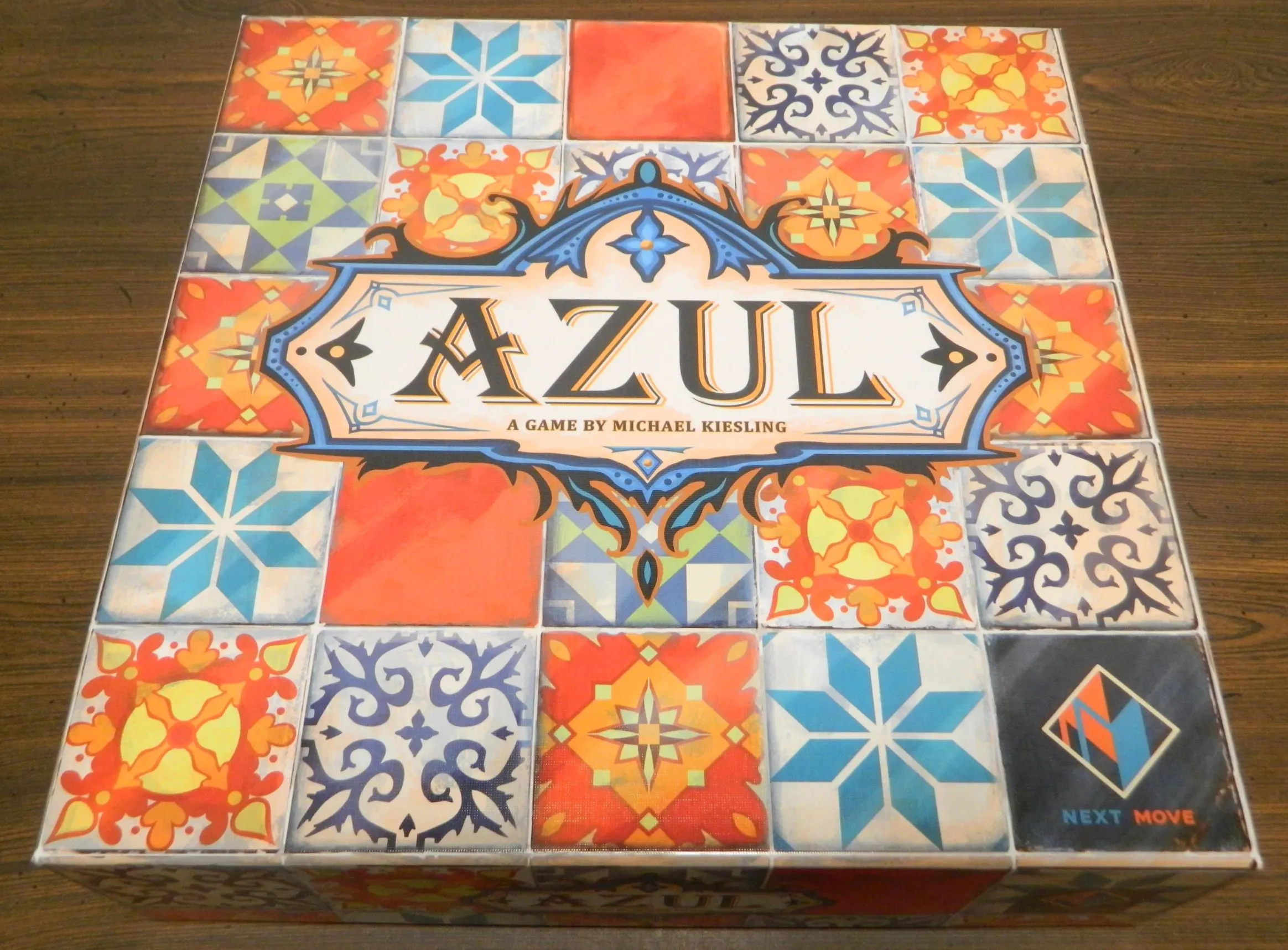
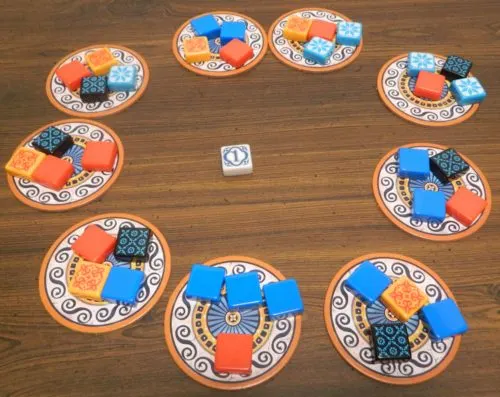
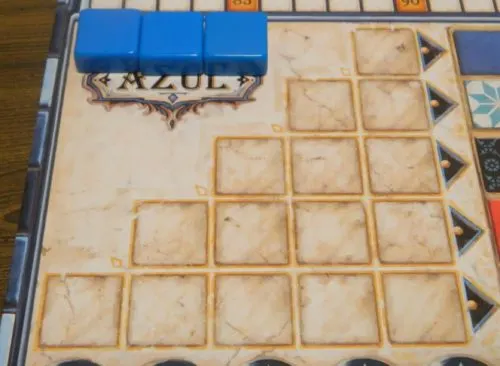
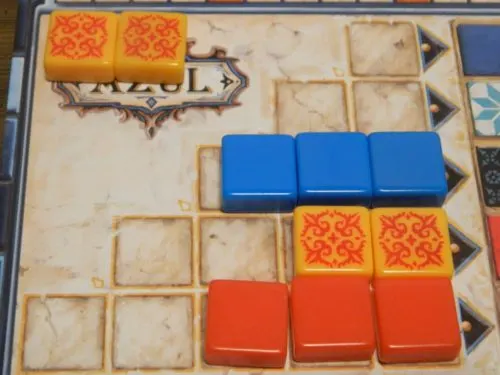
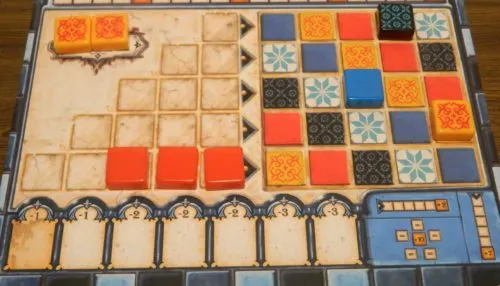
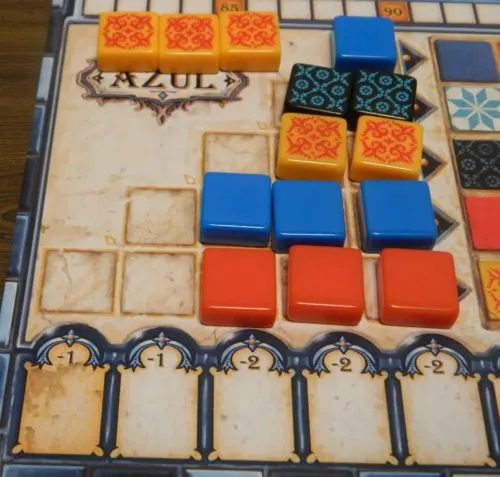
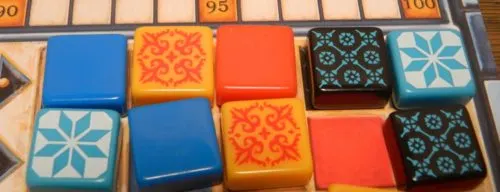
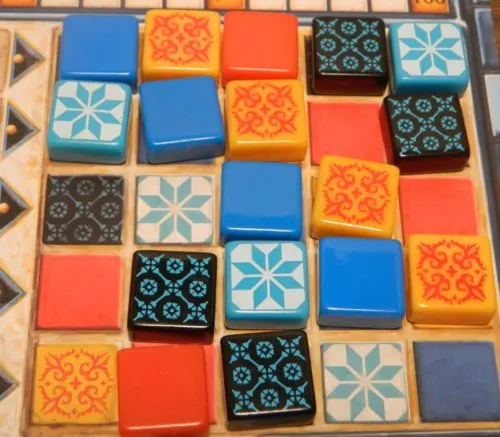
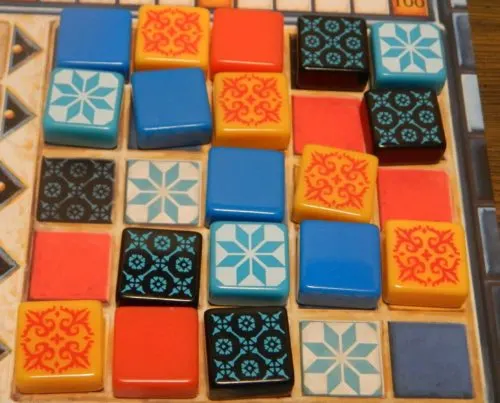
Stephane Cloutier
Thursday 30th of January 2020
I love this game, very fun, simple mechanic but stills a lot of strategy. I suggest using this companion app to keep score and avoid knocking the marker or make mistakes:
https://play.google.com/store/apps/details?id=io.lonelygames.azulscoring